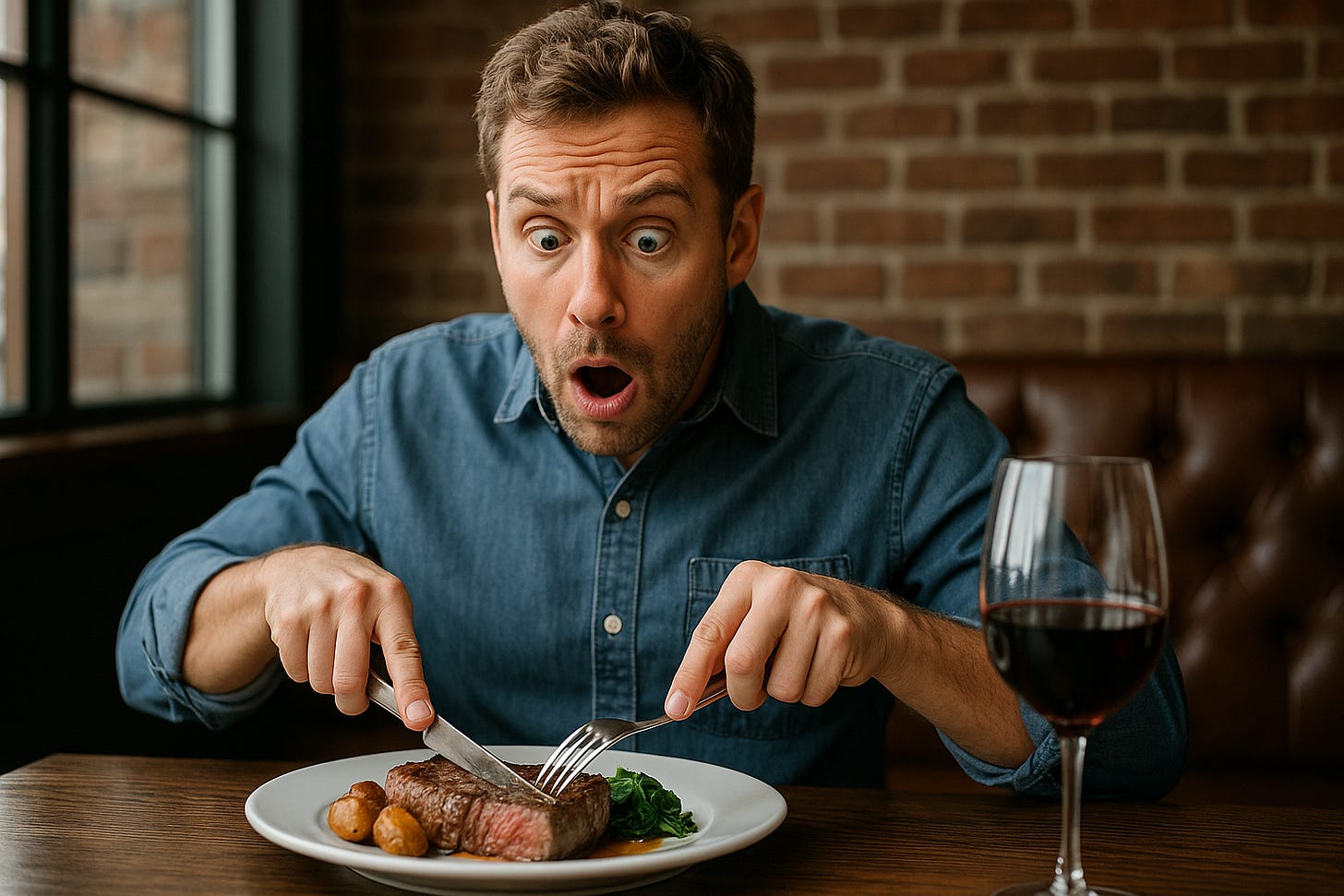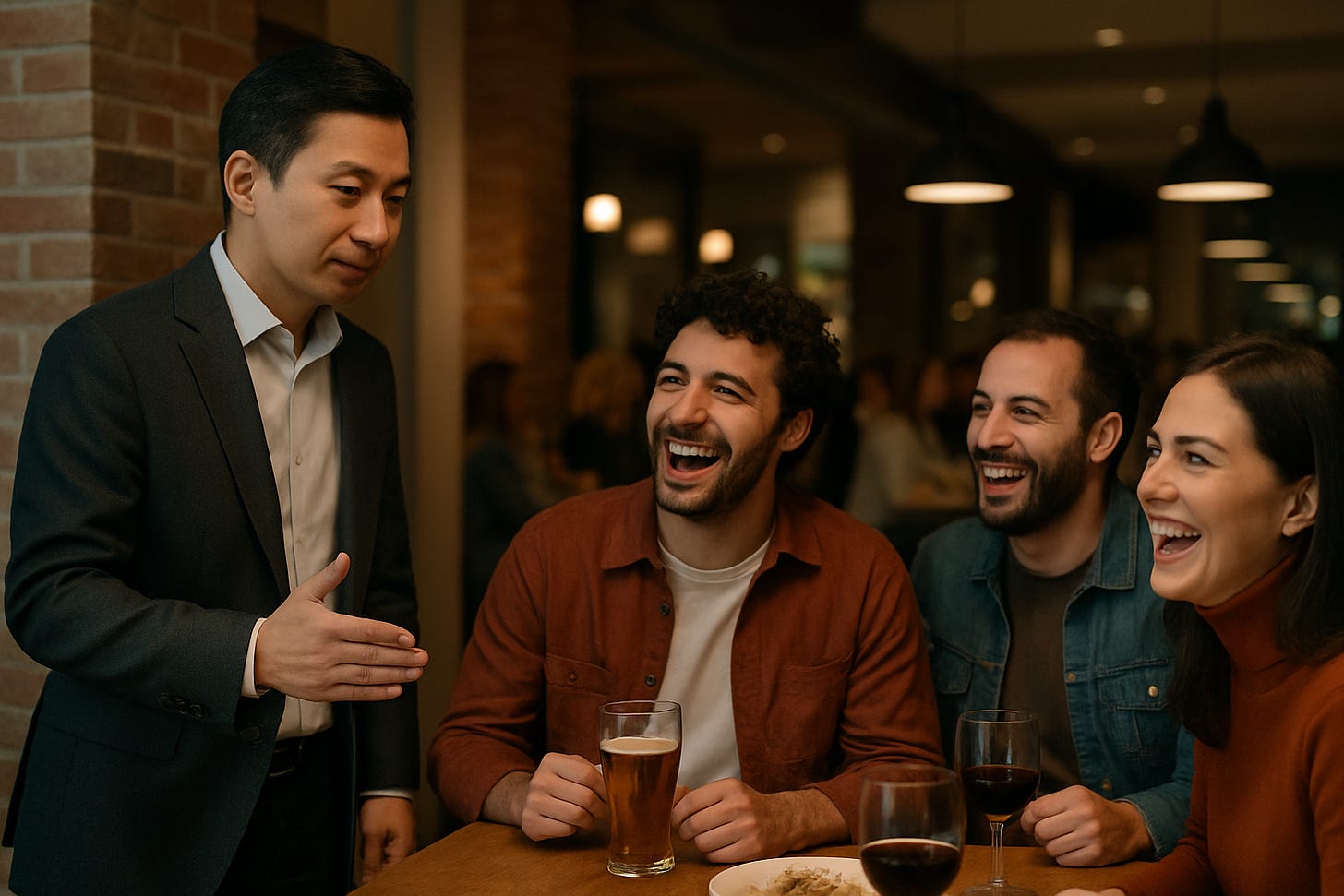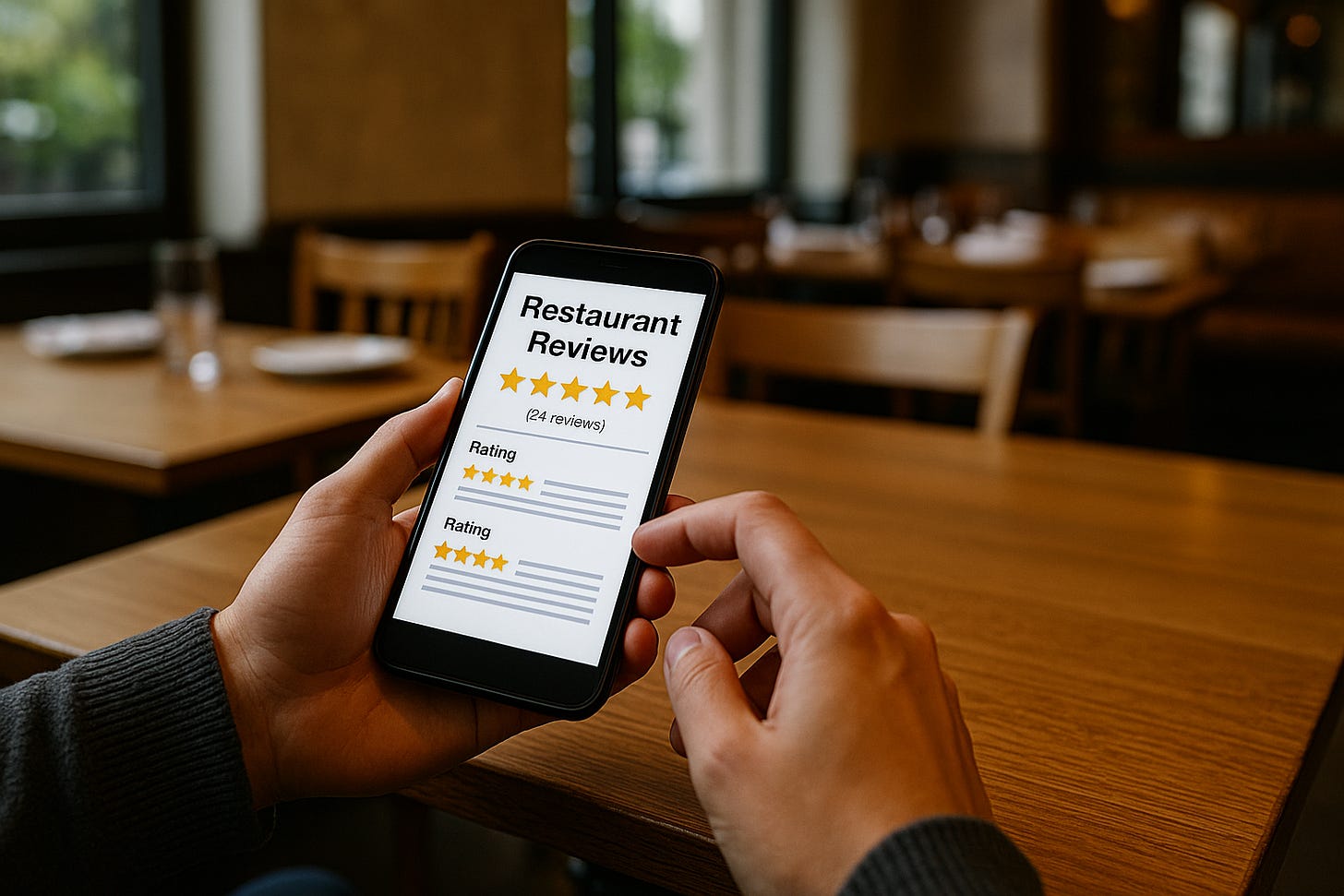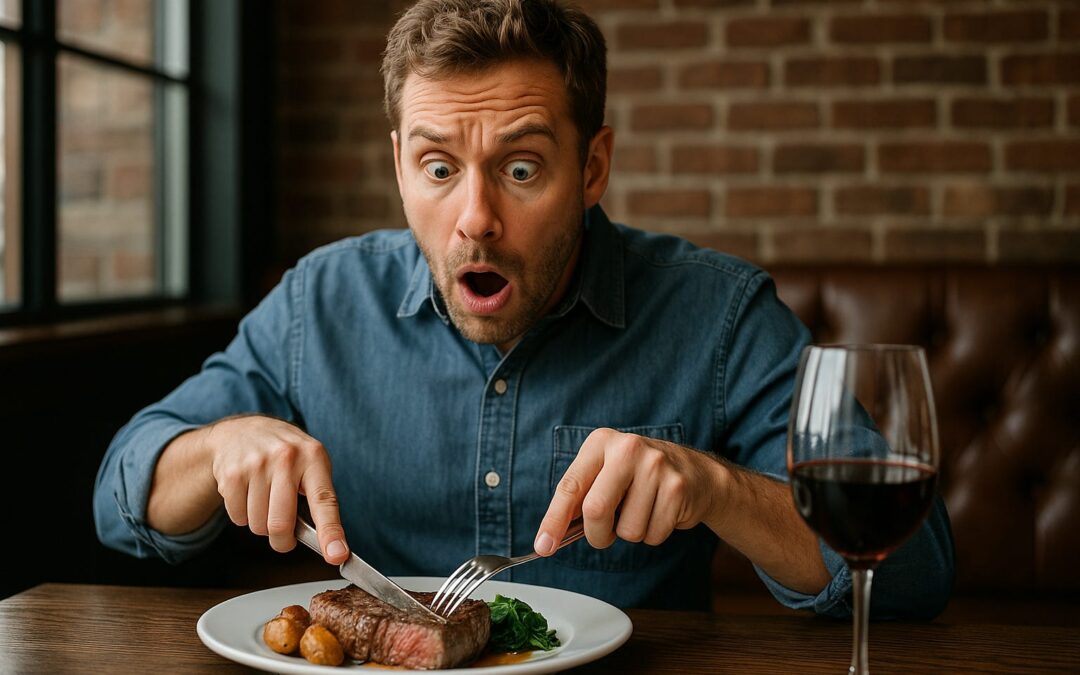
by lspeed | Jul 27, 2025 | BLACK BOX: RANTS, RAVES, REVIEWS & RECIPES
Right up front – none of these reviews were written about us, but we collected them because they’re too odd not to share. We also use them for training purposes of our service team. So here, for your amusement and maybe disbelief, are 20 of the weirdest steakhouse reviews we have found over time.
1. “Too much meat.”
“Everything was meat. Where were the salads? I left feeling like a caveman.”
Salads are great, but this is a steakhouse, not a spa café.
2. “They refused to cook it well-done twice.”
“Sent it back to be more well-done. Chef refused. It’s my steak. I should decide.”
At some point, it’s not steak—it’s charcoal.
3. “Too smoky. Smelled like steak.”
“Place smelled like grilled meat. Clothes reeked after. Not cute.”
We’re assuming this wasn’t meant as a compliment, but we’ll take it.
4. “Too many steak knives on the table.”
“Each person got a big knife. Felt a bit aggressive, like we were gearing up for battle.”
We call it being prepared. It’s a steakhouse, not a salad bar.
5. “The cow probably had feelings.”
“Felt bad eating steak. Cows are emotional beings. Won’t come back.”
We get it—but we’re still a steakhouse.
6. “The steak was pink inside. That’s raw!”
“Ordered medium. It came pink and juicy. That’s raw meat. Disgusting.”
That’s actually how it’s supposed to be. Science agrees.
7. “The menu had too many types of steak. Got stressed.”
“There were like ten different cuts. I got overwhelmed and just ordered a burger. Felt judged.”
We offer variety so you can find your favorite—but no pressure, the burger’s great too.
8. “Too quiet. I could hear people chewing.”
“The vibe was too silent. All I heard was knives and chewing. Gross.”
Bring friends. Or earbuds.
9. “Didn’t do the steak dance like in Brazil.”
“In Brazil they spin knives and do shows. Here, just boring meat service. No entertainment.”
Sounds like someone booked the wrong continent.
10. “The steak tasted like beef.”
“Not a fan. It had a strong beef flavor. Not what I expected.”
…that’s kind of the idea.
11. “Didn’t offer gold flakes on my Wagyu.”
“Wagyu was good but didn’t feel luxury enough. Should’ve had truffle or gold flakes.”
This isn’t a Vegas nightclub.
12. “The steak wasn’t Instagram-worthy.”
“Looked brown and boring. Doesn’t pop in photos. Lost likes. 2 stars.”
We grill for mouths, not timelines.
13. “The steak made me full.”
“It was so rich and heavy I couldn’t finish. Felt overly satisfied. Not ideal.”
You’d be shocked how often this complaint actually shows up.
In Closing
In the world of hospitality, you hear everything, from heartfelt praise to utterly mystifying comments. If you’ve ever worked in hospitality, you will know this list is just the tip of the iceberg. If you’ve got a favorite weird review of your own, send it our way. We’re always collecting … we might even feature it next.
Image Credit: https://churrascophuket.com
_ _ _
© CHURRASCO PHUKET STEAKHOUSE / ALL RIGHTS RESERVED
Reprinting, reposting & sharing allowed, in exchange for a backlink and credits
Churrasco Phuket Steakhouse serves affordable Wagyu and Black Angus steaks and burgers. We are open daily from 12noon to 11pm at Jungceylon Shopping Center in Patong / Phuket.
We are family-friendly and offer free parking and Wi-Fi for guests. See our menus, reserve your table, find our location, and check all guest reviews here:
https://ChurrascoPhuket.com/
#Churrascophuket #jungceylon #phuketsteakhouse #affordablewagyu #wagyu
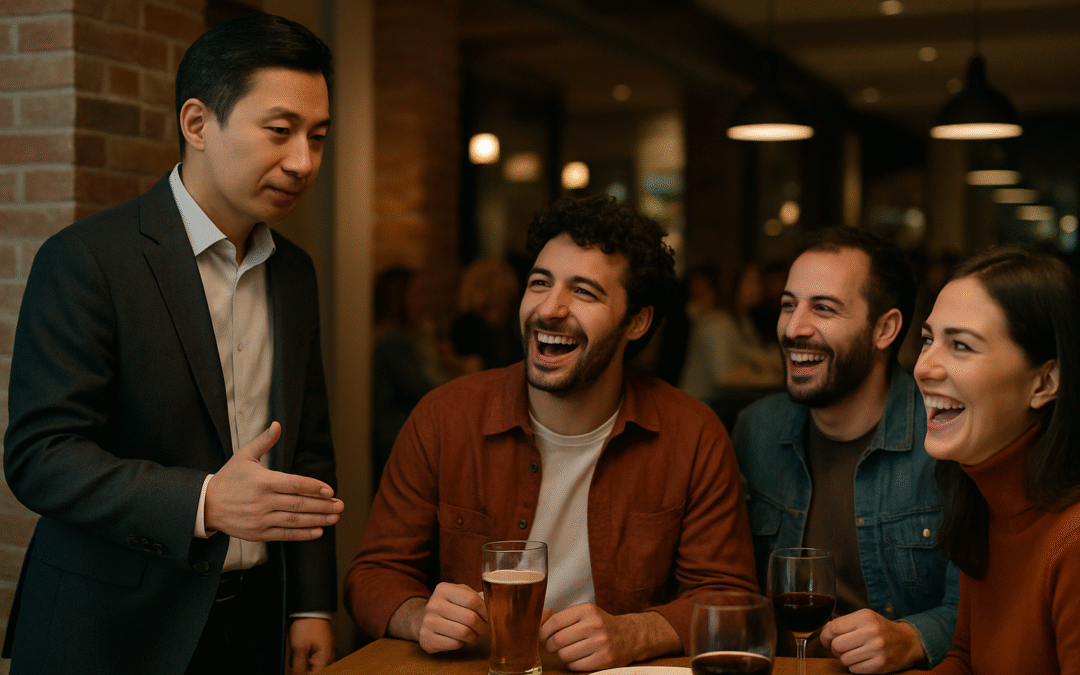
by lspeed | Jul 13, 2025 | BLACK BOX: RANTS, RAVES, REVIEWS & RECIPES
In the restaurant world, the phrase “the customer is always right” is often treated as untouchable. But anyone who’s spent time in hospitality knows it’s far from universally true. Guests can be wrong. They can be rude, unreasonable, manipulative, or even outright dishonest. Pretending otherwise helps no one. Not the team, not the business, and often not even the guest themselves. At the same time, it’s crucial to remember: guests are still guests. That status carries weight. How an establishment handles difficult moments, without losing professionalism, integrity, or warmth, often defines the experience more than the food or setting ever could.
There’s a fine line every restaurateur or manager has to walk: protecting staff morale and operational integrity while still making guests feel respected, even when their behavior is far from ideal. The goal isn’t to reward bad behavior, nor to engage in conflict, but to guide situations toward resolution with clarity and poise. Below are five all-too-common guest scenarios, along with proven techniques to defuse tension and redirect things in a constructive direction.
1. The Table Tyrant
Scenario: A guest is pushy, demanding immediate seating, rushing orders, or addressing staff in a disrespectful tone.
Defusing Technique: Calm Reframing with Boundaries
Instead of reacting emotionally, it helps to calmly reinforce fairness and order:
“We’ll make sure everything runs smoothly for you — and we’re working through all tables in order to ensure everyone is treated equally. Thanks for your patience.”
This resets expectations without escalating the tone, and reminds the guest that others are being considered too.
2. The Review Blackmailer
Scenario: A guest uses the threat of a negative online review to demand freebies or preferential treatment.
Defusing Technique: Shift Focus to Direct Resolution
Rather than respond to the threat, it’s better to bring the conversation back to real-time problem solving:
“We care about every guest’s experience, and would rather fix any issues now than hear about them later. Let’s talk through what’s not working so we can make it right.”
This establishes fairness without giving in to coercion.
3. The Drunk
Scenario: A guest becomes intoxicated and starts to disrupt the atmosphere — through volume, behavior, or attitude.
Defusing Technique: Quiet Concern and a Gentle Redirect
It’s important to approach this discreetly and with care:
“Just checking in — everything alright? If you need a moment or some water, we’re happy to help.”
By framing the intervention as concern rather than correction, it tends to reduce defensiveness and keeps the tone non-confrontational.
4. The Dish Denier
Scenario: A guest claims their meal is incorrect or unsatisfactory only after finishing most of it.
Defusing Technique: Empathetic Acknowledgment and a Path Forward
Rather than accuse or dispute, acknowledge the concern and move forward:
“Thanks for bringing this up — we want you to enjoy your meal fully. Let’s find a way to improve the experience from here.”
Even if the complaint seems disingenuous, a composed response avoids escalation and often reveals the guest’s true intent.
5. The Disruptive Group
Scenario: A large, lively group becomes too loud or disruptive for other diners.
Defusing Technique: Tap into Group Leadership
Engaging the most influential person at the table one-on-one can shift the dynamic:
“Looks like everyone’s having a great time, which we love to see. Just a small favor — a couple nearby guests are struggling to hear each other, so we’d appreciate your help in keeping things enjoyable for everyone.”
This technique avoids public embarrassment while encouraging self-moderation from within the group.
Balancing, Not Absolutes
These situations are part of the fabric of hospitality. They can’t be eliminated, only managed — and how they’re managed reflects the philosophy of the business itself. Hospitality is not submission. It’s not about letting guests behave however they please. But neither is it about asserting control or being “right” at all costs.
The aim is to uphold a respectful environment, keep the atmosphere intact, and resolve friction with professionalism. The saying needs updating: guests aren’t always right, but they are always guests. And when that principle guides how a restaurant responds to tension, the outcome is almost always better for everyone involved.
Image Credit: https://insider.churrascophuket.com
_ _ _
© CHURRASCO PHUKET STEAKHOUSE / ALL RIGHTS RESERVED
Reprinting, reposting & sharing allowed, in exchange for a backlink and credits
Churrasco Phuket Steakhouse serves affordable Wagyu and Black Angus steaks and burgers. We are open daily from 12noon to 11pm at Jungceylon Shopping Center in Patong / Phuket.
We are family-friendly and offer free parking and Wi-Fi for guests. See our menus, reserve your table, find our location, and check all guest reviews here:
https://ChurrascoPhuket.com/
#Churrascophuket #jungceylon #phuketsteakhouse #affordablewagyu #wagyu
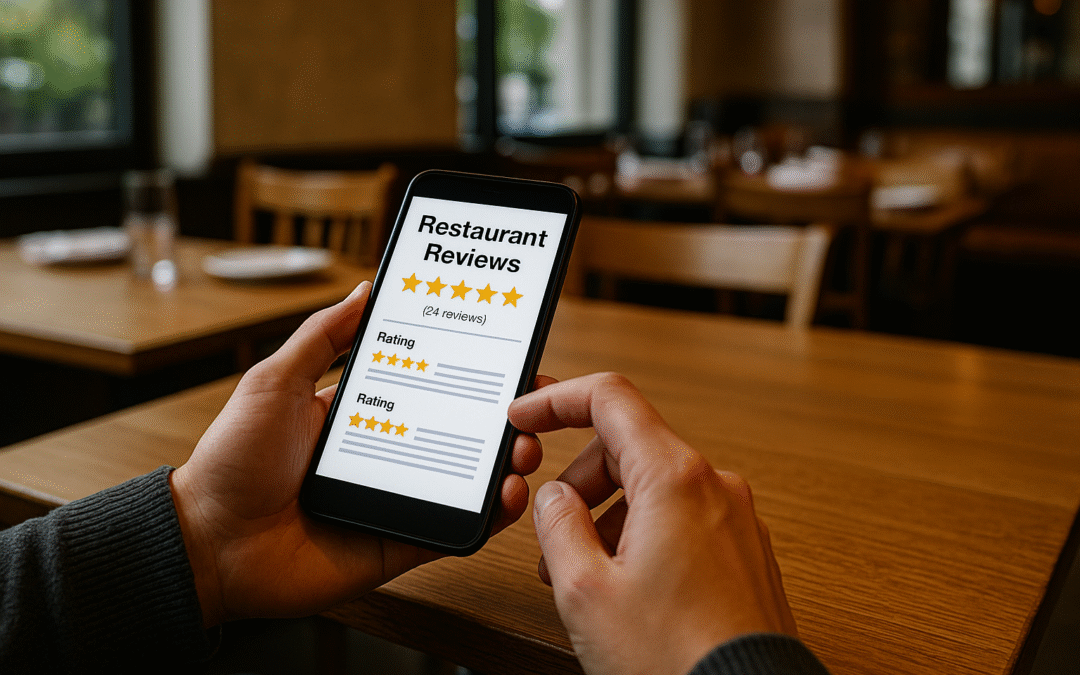
by lspeed | Jun 29, 2025 | BLACK BOX: RANTS, RAVES, REVIEWS & RECIPES
As a restaurant owner, I welcome honest feedback. It helps us grow, keeps us accountable, and drives business. But over the past few years, online reviews have shifted from being helpful to increasingly hazardous. What once empowered consumers and businesses alike is now riddled with credibility issues, flawed filtering systems, and an absence of accountability on the platforms that host them.
Google’s AI Nonsense
Google, for instance, recently implemented AI-driven moderation of reviews. In theory, this should help weed out fake or malicious content. But in practice, the algorithm is blunt. We’ve had several legitimate, positive reviews from real guests disappear without explanation. These weren’t bots or spam—they were detailed, genuine accounts from happy diners. Yet there’s no recourse. No appeal. No person to talk to. Once the system flags a review, it vanishes into the void.
TripAdvisor’s Freefall
Once the go-to platform for travelers and diners, the platform always had and still has major flaws. The problem isn’t just fake reviews, it’s the lack of any interest in addressing them. For years, restaurant owners pleaded with them to investigate suspicious reviews or restore wrongly removed ones, only to be met with canned responses (if at all), or stone cold silence. It’s no surprise the platform’s popularity is in free fall. When businesses are treated as adversaries rather than partners, trust erodes fast.
The Litigation Response
In Germany, the situation has flipped in the opposite direction. Restaurateurs there have started using the country’s notoriously complex legal system to demand the removal of negative reviews. Send a legal notice to Google, and the company removes the review, no questions asked. That might sound like a win for business owners, but it’s just another flawed extreme.
And it’s not just a Germany problem. In Italy, businesses routinely sue for defamation over TripAdvisor reviews. Some courts have sided with them, leading to jail time for fake reviewers in some cases. In Thailand, strict defamation laws mean even a negative but truthful review can bring legal threats.
Reviewers themselves now have no way to contest such takedowns. Transparency is lost, and the public ends up with a sanitized picture rather than the full truth. So now guests self-censor, and platforms overreact to avoid litigation.
Three Suggestions
-
Transparent Moderation Logs: Platforms should provide businesses and reviewers with a clear log of why a review was removed or rejected. If an AI flagged it, say why. If a human did, provide evidence. No more silent deletions.
-
Verified User Programs: Require at least a shred of proof-of-purchase or visit confirmation for reviews to be published. Some platforms have flirted with this idea but never implemented it meaningfully. A verified review is more credible for everyone.
-
Balanced Appeal Systems: Both reviewers and businesses should be able to challenge decisions, whether it’s removal or publication. A basic arbitration step (even automated) would be fairer than the current black box approach.
The review ecosystem that is broken from both ends. Businesses are frustrated, guests feel powerless, and platforms offer little clarity. We need to move toward a review culture that rewards honesty, not manipulation, whether algorithmic or legal. Until platforms invest in real accountability, we’ll continue living in a world where the loudest voices, not the truest ones, shape reputations.
Image Credit: https://www.churrascophuket.com/
_ _ _
© CHURRASCO PHUKET STEAKHOUSE / ALL RIGHTS RESERVED
Reprinting, reposting & sharing allowed, in exchange for a backlink and credits
Churrasco Phuket Steakhouse serves affordable Wagyu and Black Angus steaks and burgers. We are open daily from 12noon to 11pm at Jungceylon Shopping Center in Patong / Phuket.
We are family-friendly and offer free parking and Wi-Fi for guests. See our menus, reserve your table, find our location, and check all guest reviews here:
https://ChurrascoPhuket.com/
#Churrascophuket #jungceylon #phuketsteakhouse #affordablewagyu #wagyu

by lspeed | Jun 15, 2025 | BLACK BOX: RANTS, RAVES, REVIEWS & RECIPES
If you owned a spot in a tourist-heavy area, your rank on TripAdvisor wasn’t just a number, it was currency. Guests would literally walk in, phone in hand, quoting your position on the local ranking like it was gospel. Back then, we all played the game. We monitored our reviews, responded diligently, and hoped to climb just a little higher in the rankings. It wasn’t perfect, but it mattered.
Fast forward to today, and it’s a different story. TripAdvisor doesn’t hold the same weight in the restaurant world. It’s not completely irrelevant, but it’s not where most of us are focusing our attention any more. The reasons are tech shifts, changing customer habits, and some serious missteps on TripAdvisor’s part.
Google Changed The Game
These days, when someone searches for a place to eat, they don’t head to TripAdvisor, they Google it. And Google doesn’t just give you directions. It hands you reviews, photos, menus, opening hours. It lets you book a table or order online, all without ever leaving the search page. As restaurant owners, we see the difference. A few years ago, customers used to say, “I found you on TripAdvisor.” Now, it’s almost always Google. That shift has made TripAdvisor feel more like an afterthought than a must-have.
Trust Took a Hit
TripAdvisor’s credibility problem has been brewing for a while. Sure, it’s still possible to find thoughtful, honest reviews there, but it’s also been plagued by manipulation. Positive reviews can be bought or pushed. Negative ones can be weaponized. And while TripAdvisor claims to filter fake reviews, most of us in the business have seen questionable ones slip through. Google isn’t perfect either, but it has one thing going for it: accountability. Reviews are usually tied to real accounts, sometimes even with location data verifying the visit. That extra layer makes a difference.
Using TripAdvisor Feels… Tired
Managing a restaurant listing on TripAdvisor is clunky. The backend feels like it hasn’t changed in a decade. Messaging tools are clumsy, updates are slow, and the constant push to pay for “profile upgrades” gets old fast. From a guest’s point of view, it’s not much better. The site is ad-heavy, laggy, and awkward to navigate, especially when compared to the fast interfaces of Google, Instagram, or TikTok. In 2025, that matters.
Diners Have Moved On
Let’s face it: people don’t discover restaurants through text-heavy review sites anymore. They find them in a reel, a TikTok, a beautifully shot photo with a “must-try” caption. A single viral video can fill a dining room faster than a hundred glowing write-ups on TripAdvisor. And in different parts of the world, regional platforms have taken over. OpenRice, TheFork, even Facebook groups are where the local buzz lives now.
We’re Not Sad to See It Go
Here’s something many restaurant owners won’t say out loud: we’re relieved to see TripAdvisor lose its grip. For years, we felt held hostage by a platform that offered little recourse when someone left a false or malicious review. The appeal system was opaque at best, indifferent at worst. You could shout into the void and rarely get a reply. That kind of carelessly wielded power left a bad taste, and seeing that influence fade is a welcome change.
What We Focus on Now
These days, we keep our Google presence polished. We stay active on Instagram. We make sure menus are updated and that the guest experience feels authentic and engaging, online and offline. TripAdvisor is still there, but it’s turning into background noise. We glance at it now and then, but we don’t build our strategy around it. Unless TripAdvisor undergoes a serious reinvention, its future looks limited. To stay relevant, it would need to rebuild trust, modernize its tools, and actually respond to the needs of the businesses it relies on.
The Next Shift: AI & the End of Endless Reviews
There’s something else on the horizon, too: conversational AI. People can now ask tools like ChatGPT for restaurant suggestions tailored to their mood, location, and dietary needs, and get answers instantly. These AI tools pull from aggregated data, summarizing thousands of reviews without users needing to read a single one. The power is shifting from platforms that host reviews to tools that distill them.
For us as restaurant owners and managers, it means being consistent across platforms and making sure the overall online picture — photos, menus, hours, reviews — reflects what we really offer. Because in a world of AI summaries, one bad outlier can carry more weight than ever.
Image Credit: https://churrascophuket.com
_ _ _
© CHURRASCO PHUKET STEAKHOUSE / ALL RIGHTS RESERVED
Reprinting, reposting & sharing allowed, in exchange for a backlink and credits
Churrasco Phuket Steakhouse serves affordable Wagyu and Black Angus steaks and burgers. We are open daily from 12noon to 11pm at Jungceylon Shopping Center in Patong / Phuket.
We are family-friendly and offer free parking and Wi-Fi for guests. See our menus, reserve your table, find our location, and check all guest reviews here:
https://ChurrascoPhuket.com/
#Churrascophuket #jungceylon #phuketsteakhouse #affordablewagyu #wagyu
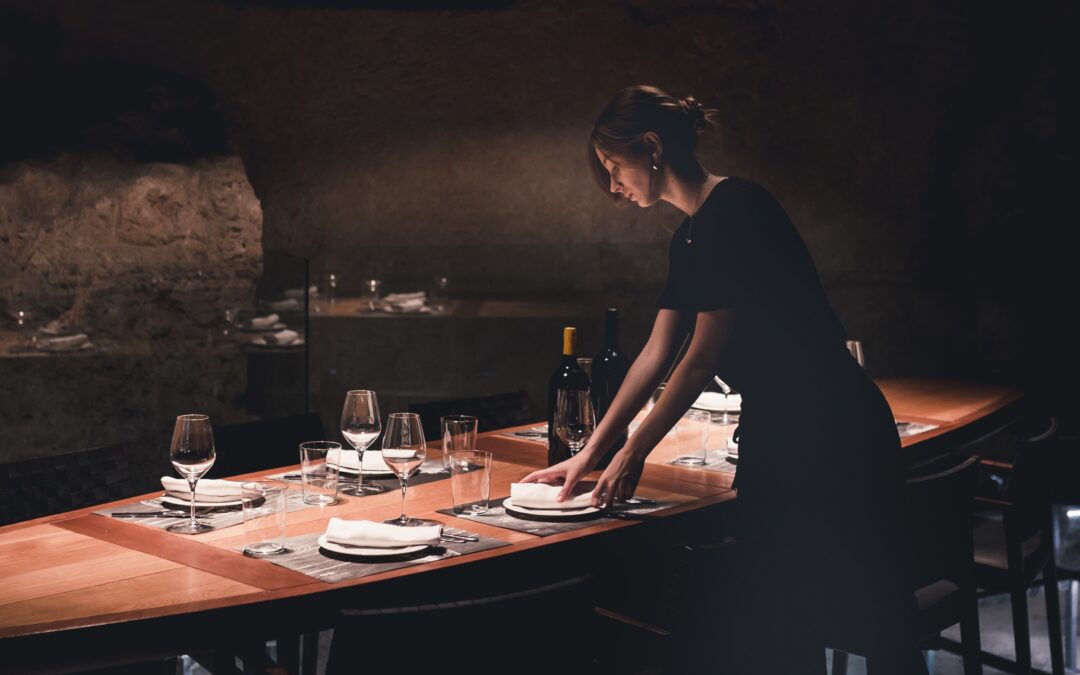
by Ross Kingsley | Jun 1, 2025 | BLACK BOX: RANTS, RAVES, REVIEWS & RECIPES
There was a time when going out to eat felt like a very special moment. Not just a pause in the day, but something that carried meaning. A little ritual. You dressed up, made a plan, maybe even looked forward to it all week. It wasn’t about convenience. It was about connection. And honestly, I miss that.
These days, dining out feels different. We go because we’re tired, because our schedules are packed, or because cooking feels like a chore. For many, it’s no longer a treat—it’s just part of the routine. And in becoming so familiar, it’s lost something.
When Restaurants Felt Human
What I remember most from the restaurants I grew up with wasn’t the food. It was how they made you feel. The neighborhood spot where the owner waved you in. The elegant restaurants where my dad entertained clients, sometimes allowing me to tag along. Tableside gueridon services with flambéed dishes and second servings. well dressed staff remembering what you ordered last time, and offering it without asking. The feeling of being seen—like you mattered.
You still find places like that. But they’re getting harder to come by. Small, independent restaurants—the kind that quietly anchor a community—are being squeezed out. Rents climb, staffing gets tougher, and chains move in. What survives is often what cab be scaled. It feels strange and uncomfortable. There are more restaurants than ever, yet fewer and fewer feel personal and unique.
From Hospitality to System
As dining became routine, the industry adapted. Menus got templated and digitised. Dining rooms were built to be branded, not warm. What was once a craft turned into a system. And somewhere in that push for efficiency, a lot of the humanity faded out.
Now we order through tablets, and get served by someone who might not be there next week. The experience feels scripted—polite, but detached. I’ve had meals recently that were perfectly fine, and yet I walked out feeling nothing. Not because the food was bad—but because there was no spark. No care.
Designed for the Scroll, Not the Table
Social media’s influence hasn’t helped. Many restaurants today feel built for the camera more than the customer. Beautiful dishes, stylized lighting, catchy wall quotes—all designed to be posted, not savored. And then there’s the increasingly controversial influencer economy. A viral dish can pack a restaurant overnight, even if the food is just average. The algorithm rewards aesthetics, not substance. And when style outweighs care, the experience becomes hollow. We’re dining for the scroll, not the moment.
Dining, Reduced to Transaction
We’ve also blurred the line between dining and delivery. Apps make it easier than ever to eat from restaurants without stepping inside one. But the cost is the experience. Restaurants become vendors, not venues. Food becomes product, not memory. Even when we do dine out, phones sit on the table. Meals are documented more than shared. We no longer expect a restaurant to offer meaning—just availability and speed.
A Few Still Get It Right
That said, some places still remind you why dining out can be special. Places that use technology to support the experience, not replace it. Where service feels human. Where you’re remembered. They’re not always trendy or polished. But they’re real. And real lingers longer than perfect. At Churrasco Phuket Steakhouse, this is at the core of our philosophy and daily efforts. As we keep telling out team over and over again: “We are not about selling food. We are here to make our guests happy”. It seems to work, judging by the long and growing litany of 5-star reviews on Google – and even that slowly dying legacy review site, TripAdvisor.
The Part We Play
It’s tempting to point fingers at the industry. But restaurants reflect and rrespond to demand. If we chase convenience or viral novelty over substance, the message is clear to those who invest in the restaurant business. But if at the same time, we choose the places that feel thoughtful, sincere, and human—if we reward care—we can shift the landscape.
A 2023 OpenTable survey found that nearly 80% of diners ranked “authenticity” above price or even food quality. That appetite for something real? It’s there. We just have to act on it.
And I think that’s worth remembering every time we go out to eat. Don’t you?
Image Credit: https://freepik.com
_ _ _
© CHURRASCO PHUKET STEAKHOUSE / ALL RIGHTS RESERVED
Reprinting, reposting & sharing allowed, in exchange for a backlink and credits
Churrasco Phuket Steakhouse serves affordable Wagyu and Black Angus steaks and burgers. We are open daily from 12noon to 11pm at Jungceylon Shopping Center in Patong / Phuket.
We are family-friendly and offer free parking and Wi-Fi for guests. See our menus, reserve your table, find our location, and check all guest reviews here:
https://ChurrascoPhuket.com/
#Churrascophuket #jungceylon #phuketsteakhouse #affordablewagyu #wagyu

by Ross Kingsley | May 11, 2025 | BLACK BOX: RANTS, RAVES, REVIEWS & RECIPES
Dining out is a feast for all the senses, but for some, the real show begins when the wine list lands on the table. At that moment, the act of drinking wine transforms into something more ceremonial—part theatre, part tradition, part deeply personal expression.
It starts, often, with a thoughtful pause. The guest studies the wine list with the gravity of a scholar decoding ancient script. This is not just about choosing a drink—it’s a quest for the perfect companion to the meal. And once the bottle is selected and presented, the ritual begins.
Act One: The Label Check
There’s a quick inspection of the label, followed by a gentle nod. “Ah, a 2019,” they might say, a year that may or may not hold any actual significance beyond sounding informed. Questions about terroir or oak aging may follow, not to test the sommelier, but to share in the delight of the grape’s journey.
Act Two: The Swirl and Sniff
With the glass now in hand, the guest gives it a swirl—perhaps a bit more theatrical than necessary, but still a sincere gesture. They lower their nose to the glass and inhale deeply, as if taking in a memory. “Crisp, with notes of citrus and maybe a little something herbal,” they muse. It’s less about impressing the table, more about connecting to the wine in their own poetic way.
Act Three: The Sip and Smile
The sip comes with a pause. A thoughtful moment of silence. Then a smile. “That’s really lovely.” No grand pronouncements, no overly complex metaphors—just appreciation. Whether it’s a robust Shiraz or a playful Pinot Grigio, the moment is enjoyed and shared.
The Pairing Philosopher
Some guests extend their interest by suggesting pairings to friends at the table—gently, enthusiastically. “That seafood pasta would sing with this Vermentino,” they offer, not as a rule, but as a hopeful tip. The tone is more about joy than judgment.
It’s true, not every wine lover at a restaurant is quietly sipping and nodding. Some get carried away, lost in their excitement or perhaps trying a little too hard. But more often than not, the little rituals of swirling, sniffing, and tasting aren’t just for show. They’re expressions of curiosity and affection for a timeless craft.
And for restaurants, these moments are part of what makes dining out special. Watching guests engage with the wine—not just drink it—adds richness to the experience. It reminds us that wine isn’t only about grapes and aging techniques. It’s about people, stories, and sharing something meaningful—even if it’s just over dinner.
So next time someone swirls their glass a little too dramatically or describes a Chardonnay as “sunshine in liquid form,” let them have their moment.
After all, wine is about pleasure. And pleasure, like wine, is best when enjoyed fully—even a little playfully.
Image Credit: https://churrascophuket.com
_ _ _
© CHURRASCO PHUKET STEAKHOUSE / ALL RIGHTS RESERVED
Reprinting, reposting & sharing allowed, in exchange for a backlink and credits
Churrasco Phuket Steakhouse serves affordable Wagyu and Black Angus steaks and burgers. We are open daily from 12noon to 11pm at Jungceylon Shopping Center in Patong / Phuket.
We are family-friendly and offer free parking and Wi-Fi for guests. See our menus, reserve your table, find our location, and check all guest reviews here:
https://ChurrascoPhuket.com/
#Churrascophuket #jungceylon #phuketsteakhouse #affordablewagyu #wagyu


